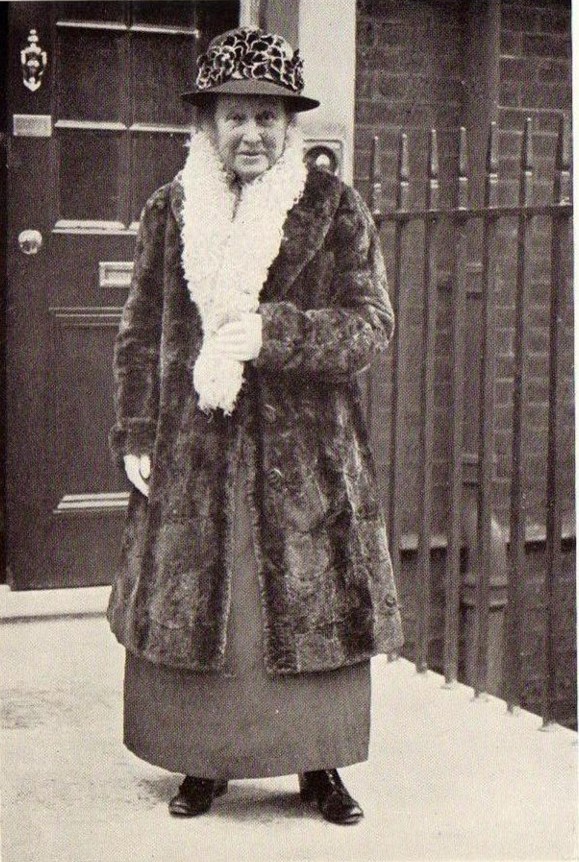Now that the Women’s Library Reading Room is open on the 4th floor of LSE Library, here is another idea for those who might want to stretch their legs during their visit.
Why not take a gentle meander along Fleet Street and visit Queen Elizabeth I as she stands in her niche over what was the entrance to the Parochial School attached to the church of St Dunstans in the West? Not only is this thought to be the only surviving statue of the Queen carved in her lifetime, but she has a very close connection to Millicent Fawcett, in whose honour the Fawcett Library (as the Women’s Library was originally known) was named.
 Statue of Queen Elizabeth I at St Dunstan’s in the West
Statue of Queen Elizabeth I at St Dunstan’s in the WestIt is thought that the statue was carved in 1586. It then led a rather adventurous life before coming to rest in this niche on the facade of St Dunstans in the West when the church was rebuilt here in the 1830s. Nearly a century later it was in a dilapidated state and its restoration was financed by Dame Millicent Fawcett and her sister, Agnes Garrett, together with ‘Miss Jones of Lincoln’s Inn’ and Gwen John. The latter was not, as is sometimes stated, Gwen John the artist, but Gwen John, playwright and actress, author of a biography ‘Queen Elizabeth’ and a play ‘Gloriana’. Gwen John, whose real name was Gladys Jones, lived with Winifred Jones (‘Miss Jones’), presumably her sister, at 9 Old Square, Lincoln’s Inn. See here for National Portrait Gallery of this Gwen John.
 Millicent Fawcett, c 1928
Millicent Fawcett, c 1928In a rather neat sequence of events, on 28 June 1928 Dame Millicent Fawcett presided at the Annual General Meeting of the Society for the Protection of Ancient Buildings, at which the preservation of old churches was the topic of discussion, on 2 July the Representation of the People (Equal Franchise) Act, for which she had been campaigning since 1866, became law, and on 31 July she unveiled the restored statue of Queen Elizabeth I. See the unveiling here, although Millicent Fawcett, modest as ever, cannot be seen. However the curtain she caused to be moved, moves. Which is sort of symbolic of the influence she exerted during her long life.
While the statue was undergoing restoration it was discovered that it had originally been coloured. So, the statue was repainted, following the original colours as closely as possible. The farthingale and corsage were white, the face was tinted a flesh colour and her crown was gilded. Alas, this colouring is no longer obvious to the passer-by and the Queen has rather faded back into the facade of the building.
Millicent Fawcett died just a few days over a year after unveiling the statue and in her will left £700 towards its upkeep, although that fund may now have been exhausted and wound up.
If you wanted to pause, you could combine veneration of the Virgin Queen and thoughts of the venerable suffrage campaigner with a coffee from the stall that is now a permanent fixture just below her niche.
#1 by Chase Livingston on April 3, 2014 - 12:56 pm
Thank you so much for continuing to share these facts of history that would otherwise be lost. I enjoy every one of your posts. I don’t know where you find it all but it is fascinating – all these great tidbits of women’s history! The details are found nowhere else. You’re really great at what you do!
#2 by womanandhersphere on April 3, 2014 - 3:17 pm
Many thanks, Chase. I appreciate your support…
Best wishes
Elizabeth
#3 by Sonya Robotham on April 15, 2017 - 3:13 am
Thank you so much for this post. I am particularly interested in the Jones’s I am currently researching Derbyshire Suffragettes and wondered if anyone had anymore infrmation on either Winifred or Gladys Jones aka Gwen John. They were born in Chesterfield Derbyshire but I cannot find any information about why and when they moved to London. Any information would be helpful.
#4 by womanandhersphere on April 17, 2017 - 10:58 am
The daughters and mother were living in London in 1901 – prob rented rooms – 34 Claverton St.Pimlico. Father, described in the Probate Register as ‘of Chesterfield’, died in Jan 1911 in Margate – his widow was one of the executors of his will..suggesting there was no family rift. I’ll let you know if I can find out more. Elizabeth
#5 by Sonya Robotham on May 17, 2017 - 2:01 pm
Thank you very much Elizabeth